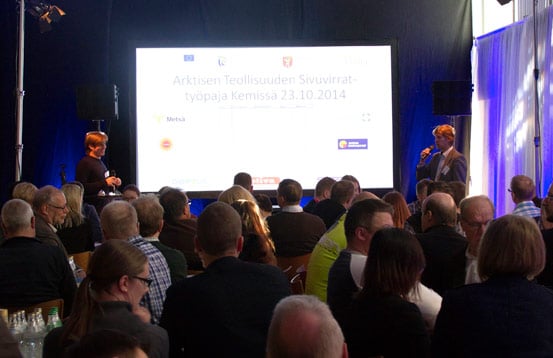
In October, Digipolis, together with Motiva and Sitra, organised a workshop planned to create a network for utilising the by-product and waste flows of industry. The objective for this network is the creation of new businesses that will also create new jobs.
The workshop brought together the producers and users of resources, as well as service providers. The purpose is to make enterprises aware on a broad scale of the opportunities offered by industrial symbioses and circular economy thinking, and to build a database of companies producing or utilising recyclable raw materials. An example of these opportunities is offered by the Kemi mill of Metsä Fibre.
"Riffler waste is created in the wood room. This can be used as mulch in landscaping and, after screening, as fuel. Ashes from the bark-burning boiler can be used in earth construction. Ash and ash-mixtures can replace soil in certain earth structures such as in earth filling, protective layers and road structures", explains Marika Alapoikela, the area environmental manager for Metsä Fibre's Kemi mill.
"Ash can also be used as fertiliser in forests low in potassium and phosphorus. Light ashes are also good raw materials for the fertiliser and concrete industries," Alapoikela continues.
Innovations and cooperation
According to Jyri Arponen, Sitra's business director focusing on industrial symbioses, the highly successful Digipolis workshop attracted around 50 companies.
"There are major production plants of basic industry, as well as innovative companies offering technological services, in Sea Lapland. The extractive and forest industries in the area have a long history in utilising industrial by-products. The benefits of industrial symbioses and new business opportunities between different sectors have been understood here", Arponen says.
Arponen says that technological development, price fluctuations of raw materials, the increasing growth and new opportunities created by ecological considerations make the 1.2 million tonne untapped by-product flows in the area attract new investments and innovations.
"The development of industrial competitiveness requires both bold innovations and cooperation. This area has both. If we want to realise the area's growth potential and excellent level of determination, we need clear coordination and competent people. Digipolis and Kari Poikela and his team have shown to be just that in the past.
Leading the way in Europe
Arponen stresses that Lapland was chosen as one of Europe’s model regions in cluster development, alongside six other top areas. The selection was made by the Commission's Enterprise and Industry Directorate-General from among 44 candidates. Arponen says that to be selected among the best areas in this respect opens up new opportunities for achieving ambitious recycling targets.
"The model areas were selected to develop and implement new procedures for European clusters with a view to making innovative use of the natural strengths of the areas." The model areas have access to the European Cluster Observatory's expertise.
Text by Mika Kulju
Photos by Jan Åqvist
Fact box
- Industries operating in Sea Lapland produce 1.2 million tonnes of by-products and waste each year.
- The international target is to recycle 75% of all raw materials by the year 2030.
- Finland is one of the leading European countries in recycling and recycles 46% of all raw materials.